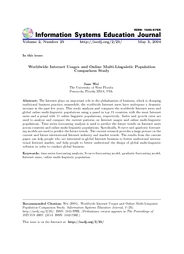Volume 2
Volume 2, Number 25 |
May 3, 2004 |

|
June Wei
|
Abstract: The Internet plays an important role in the globalization of business, which is changing traditional business practice; meanwhile, the worldwide Internet users have undergone a dramatic increase in the past few years. This study analyzes and compares the worldwide Internet users and global online multi-linguistic populations using a panel in top 15 countries with the most Internet users and a penal with 11 online linguistic populations, respectively. Index and growth rates are used to analyze and compare the current patterns on Internet usages and online multi-linguistic populations. Time series forecasting analysis is used to predict the future trends on Internet users across countries and online multi-linguistic populations. Specifically, S-curve and quadratic forecasting models are used to predict the future trends. The current research provides a large picture on the current and future international Internet industry and market trends. The results from the current paper can help people who are interested in global Internet business to better understand international Internet market, and help people to better understand the design of global multi-linguistic websites in order to conduct global business.
Keywords: time series forecasting analysis, S-curve forecasting model, quadratic forecasting model, Internet users, online multi-linguistic population
Download this issue: ISEDJ.2(25).Wei.pdf (Adobe PDF, 16 pages, 988 K bytes)
Preview the contents: jWei.txt (ASCII txt, 35 K bytes)
Recommended Citation: Wei (2004). Worldwide Internet Usages and Online Multi-Linguistic Population Comparison Study. Information Systems Education Journal, 2 (25). http://isedj.org/2/25/. ISSN: 1545-679X. (Preliminary version appears in The Proceedings of ISECON 2003: §3114. ISSN: 1542-7382.)